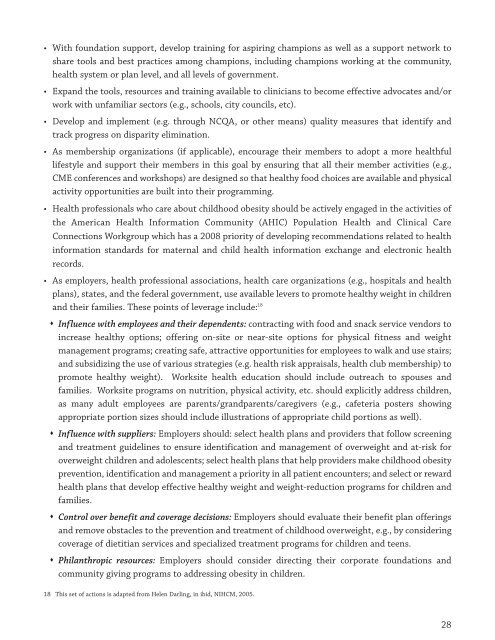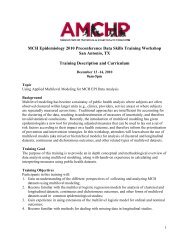Childhood Obesity: The Role of Health Policy - Association of ...
Childhood Obesity: The Role of Health Policy - Association of ...
Childhood Obesity: The Role of Health Policy - Association of ...
Create successful ePaper yourself
Turn your PDF publications into a flip-book with our unique Google optimized e-Paper software.
• With foundation support, develop training for aspiring champions as well as a support network to<br />
share tools and best practices among champions, including champions working at the community,<br />
health system or plan level, and all levels <strong>of</strong> government.<br />
• Expand the tools, resources and training available to clinicians to become effective advocates and/or<br />
work with unfamiliar sectors (e.g., schools, city councils, etc).<br />
• Develop and implement (e.g. through NCQA, or other means) quality measures that identify and<br />
track progress on disparity elimination.<br />
• As membership organizations (if applicable), encourage their members to adopt a more healthful<br />
lifestyle and support their members in this goal by ensuring that all their member activities (e.g.,<br />
CME conferences and workshops) are designed so that healthy food choices are available and physical<br />
activity opportunities are built into their programming.<br />
• <strong>Health</strong> pr<strong>of</strong>essionals who care about childhood obesity should be actively engaged in the activities <strong>of</strong><br />
the American <strong>Health</strong> Information Community (AHIC) Population <strong>Health</strong> and Clinical Care<br />
Connections Workgroup which has a 2008 priority <strong>of</strong> developing recommendations related to health<br />
information standards for maternal and child health information exchange and electronic health<br />
records.<br />
• As employers, health pr<strong>of</strong>essional associations, health care organizations (e.g., hospitals and health<br />
plans), states, and the federal government, use available levers to promote healthy weight in children<br />
and their families. <strong>The</strong>se points <strong>of</strong> leverage include: 18<br />
� Influence with employees and their dependents: contracting with food and snack service vendors to<br />
increase healthy options; <strong>of</strong>fering on-site or near-site options for physical fitness and weight<br />
management programs; creating safe, attractive opportunities for employees to walk and use stairs;<br />
and subsidizing the use <strong>of</strong> various strategies (e.g. health risk appraisals, health club membership) to<br />
promote healthy weight). Worksite health education should include outreach to spouses and<br />
families. Worksite programs on nutrition, physical activity, etc. should explicitly address children,<br />
as many adult employees are parents/grandparents/caregivers (e.g., cafeteria posters showing<br />
appropriate portion sizes should include illustrations <strong>of</strong> appropriate child portions as well).<br />
� Influence with suppliers: Employers should: select health plans and providers that follow screening<br />
and treatment guidelines to ensure identification and management <strong>of</strong> overweight and at-risk for<br />
overweight children and adolescents; select health plans that help providers make childhood obesity<br />
prevention, identification and management a priority in all patient encounters; and select or reward<br />
health plans that develop effective healthy weight and weight-reduction programs for children and<br />
families.<br />
� Control over benefit and coverage decisions: Employers should evaluate their benefit plan <strong>of</strong>ferings<br />
and remove obstacles to the prevention and treatment <strong>of</strong> childhood overweight, e.g., by considering<br />
coverage <strong>of</strong> dietitian services and specialized treatment programs for children and teens.<br />
� Philanthropic resources: Employers should consider directing their corporate foundations and<br />
community giving programs to addressing obesity in children.<br />
18 This set <strong>of</strong> actions is adapted from Helen Darling, in ibid, NIHCM, 2005.<br />
28



